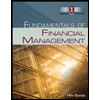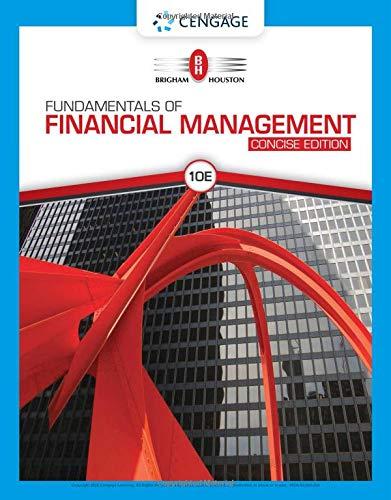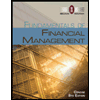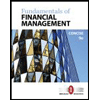
PRIN.OF CORPORATE FINANCE
13th Edition
ISBN: 9781260013900
Author: BREALEY
Publisher: RENT MCG
expand_more
expand_more
format_list_bulleted
Textbook Question
Chapter 7, Problem 6PS
Stocks vs. bonds Each of the following statements is dangerous or misleading. Explain why.
- a. A long-term U.S. government bond is always absolutely safe.
- b. All investors should
prefer stocks to bonds because stocks offer higher long-runrates of return . - c. The best practical
forecast of future rates of return on the stock market is a 5- or 10-year average of historical returns.
Expert Solution & Answer
Want to see the full answer?
Check out a sample textbook solution
Students have asked these similar questions
Don't use ai tool please .
What is the primary purpose of diversification in a portfolio?
a) To maximize returnsb) To reduce riskc) To increase leveraged) To focus on a single asset class
Don't use chatgpt.
A company’s weighted average cost of capital (WACC) is used to:
A) Determine the average cost of producing goods
B) Evaluate the return on investment projects
C) Estimate the company's growth rate
D) Measure the level of debt in the company
What is the primary purpose of diversification in a portfolio?
a) To maximize returnsb) To reduce riskc) To increase leveraged) To focus on a single asset class
Chapter 7 Solutions
PRIN.OF CORPORATE FINANCE
Ch. 7 - Rate of return The level of the Syldavia market...Ch. 7 - Real versus nominal returns The Costaguana stock...Ch. 7 - Arithmetic average and compound returns Integrated...Ch. 7 - Risk premiums Here are inflation rates and U.S....Ch. 7 - Risk Premium Suppose that in year 2030, investors...Ch. 7 - Stocks vs. bonds Each of the following statements...Ch. 7 - Expected return and standard deviation A game of...Ch. 7 - Standard deviation of returns The following table...Ch. 7 - Average returns and standard deviation During the...Ch. 7 - Prob. 10PS
Ch. 7 - Prob. 11PSCh. 7 - Diversification Here are the percentage returns on...Ch. 7 - Risk and diversification In which of the following...Ch. 7 - Prob. 14PSCh. 7 - Portfolio risk To calculate the variance of a...Ch. 7 - Portfolio risk a) How many variance terms and how...Ch. 7 - Portfolio risk Table 7.8 shows standard deviations...Ch. 7 - Portfolio risk Hyacinth Macaw invests 60% of her...Ch. 7 - Stock betas What is the beta of each of the stocks...Ch. 7 - Stock betas There are few, if any, real companies...Ch. 7 - Portfolio betas A portfolio contains equal...Ch. 7 - Portfolio betas Suppose the standard deviation of...Ch. 7 - Portfolio risk Here are some historical data on...Ch. 7 - Portfolio risk Suppose that Treasury bills offer a...
Knowledge Booster
Learn more about
Need a deep-dive on the concept behind this application? Look no further. Learn more about this topic, finance and related others by exploring similar questions and additional content below.Similar questions
- I need help! A company’s weighted average cost of capital (WACC) is used to: A) Determine the average cost of producing goods B) Evaluate the return on investment projects C) Estimate the company's growth rate D) Measure the level of debt in the companyarrow_forwardNeed help!! What does the term "liquidity" refer to in finance? A) The ability to convert assets into cash quickly without significant loss of value B) The ability to increase company profits C) The level of debt in the company D) The diversity of the investment portfolioarrow_forwardI need answer step by step. A company’s weighted average cost of capital (WACC) is used to: A) Determine the average cost of producing goods B) Evaluate the return on investment projects C) Estimate the company's growth rate D) Measure the level of debt in the companyarrow_forward
- Don't use ai A company’s weighted average cost of capital (WACC) is used to: A) Determine the average cost of producing goods B) Evaluate the return on investment projects C) Estimate the company's growth rate D) Measure the level of debt in the companyarrow_forwardA company’s weighted average cost of capital (WACC) is used to: A) Determine the average cost of producing goods B) Evaluate the return on investment projects C) Estimate the company's growth rate D) Measure the level of debt in the companyarrow_forwardI need help! Which of the following best defines "diversification" in investment? A) Investing in a single type of asset for high returns B) Spreading investments across different assets to reduce risk C) Putting all funds into low-risk bonds D) Focusing on high-risk, high-return investmentsarrow_forward
- Which of the following best defines "diversification" in investment? A) Investing in a single type of asset for high returns B) Spreading investments across different assets to reduce risk C) Putting all funds into low-risk bonds D) Focusing on high-risk, high-return investmentsarrow_forwardWhich of the following best describes the "efficient market hypothesis"? A) Stocks are always priced higher than their actual value. B) It is impossible to outperform the market consistently due to all information being already reflected in stock prices. C) Only insider information can help outperform the market. D) The market reacts slowly to new information.arrow_forwardThe "time value of money" concept states that: A) Money today is worth more than the same amount in the future B) Money tomorrow is worth more than today’s money C) Money and time have no relation in financial decisions D) Time has no impact on financial investmentsarrow_forward
- I need help. If net income is $25,000 and total equity is $125,000, what is the return on equity (ROE)?A. 10%B. 15%C. 20%D. 25%arrow_forwardI need help!!Which of the following is NOT a type of financial market? A) Capital Market B) Money Market C) Labor Market D) Commodity Marketarrow_forwardWhich of the following is NOT a type of financial market? A) Capital Market B) Money Market C) Labor Market D) Commodity Marketarrow_forward
arrow_back_ios
SEE MORE QUESTIONS
arrow_forward_ios
Recommended textbooks for you
 Intermediate Financial Management (MindTap Course...FinanceISBN:9781337395083Author:Eugene F. Brigham, Phillip R. DavesPublisher:Cengage Learning
Intermediate Financial Management (MindTap Course...FinanceISBN:9781337395083Author:Eugene F. Brigham, Phillip R. DavesPublisher:Cengage Learning Fundamentals of Financial Management (MindTap Cou...FinanceISBN:9781285867977Author:Eugene F. Brigham, Joel F. HoustonPublisher:Cengage Learning
Fundamentals of Financial Management (MindTap Cou...FinanceISBN:9781285867977Author:Eugene F. Brigham, Joel F. HoustonPublisher:Cengage Learning Fundamentals of Financial Management (MindTap Cou...FinanceISBN:9781337395250Author:Eugene F. Brigham, Joel F. HoustonPublisher:Cengage Learning
Fundamentals of Financial Management (MindTap Cou...FinanceISBN:9781337395250Author:Eugene F. Brigham, Joel F. HoustonPublisher:Cengage Learning Fundamentals Of Financial Management, Concise Edi...FinanceISBN:9781337902571Author:Eugene F. Brigham, Joel F. HoustonPublisher:Cengage Learning
Fundamentals Of Financial Management, Concise Edi...FinanceISBN:9781337902571Author:Eugene F. Brigham, Joel F. HoustonPublisher:Cengage Learning Fundamentals of Financial Management, Concise Edi...FinanceISBN:9781285065137Author:Eugene F. Brigham, Joel F. HoustonPublisher:Cengage Learning
Fundamentals of Financial Management, Concise Edi...FinanceISBN:9781285065137Author:Eugene F. Brigham, Joel F. HoustonPublisher:Cengage Learning Fundamentals of Financial Management, Concise Edi...FinanceISBN:9781305635937Author:Eugene F. Brigham, Joel F. HoustonPublisher:Cengage Learning
Fundamentals of Financial Management, Concise Edi...FinanceISBN:9781305635937Author:Eugene F. Brigham, Joel F. HoustonPublisher:Cengage Learning

Intermediate Financial Management (MindTap Course...
Finance
ISBN:9781337395083
Author:Eugene F. Brigham, Phillip R. Daves
Publisher:Cengage Learning

Fundamentals of Financial Management (MindTap Cou...
Finance
ISBN:9781285867977
Author:Eugene F. Brigham, Joel F. Houston
Publisher:Cengage Learning

Fundamentals of Financial Management (MindTap Cou...
Finance
ISBN:9781337395250
Author:Eugene F. Brigham, Joel F. Houston
Publisher:Cengage Learning

Fundamentals Of Financial Management, Concise Edi...
Finance
ISBN:9781337902571
Author:Eugene F. Brigham, Joel F. Houston
Publisher:Cengage Learning

Fundamentals of Financial Management, Concise Edi...
Finance
ISBN:9781285065137
Author:Eugene F. Brigham, Joel F. Houston
Publisher:Cengage Learning

Fundamentals of Financial Management, Concise Edi...
Finance
ISBN:9781305635937
Author:Eugene F. Brigham, Joel F. Houston
Publisher:Cengage Learning
How to build an investment portfolio; Author: The Finance Storyteller;https://www.youtube.com/watch?v=K4mWd2zBYVk;License: Standard Youtube License